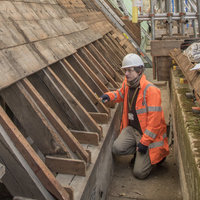Papers by Aleksandra McClain
including the URL of the record and the reason for the withdrawal request.
An elaborate and unusual mid-12th - century grave slab was recently found hidden beneath the pews... more An elaborate and unusual mid-12th - century grave slab was recently found hidden beneath the pews of the north transept of the church of All Saints, Northallerton. In its form, decoration, and identifying inscription, the monument is exceptional for the region in this period. The singular attributes of the commemorative marker also afford it particular interpretative potential. The monument provides a rare glimpse of the individuals and strata of society who were memorialized in stone in 12th - century North Yorkshire, and helps to illuminate some of the motivations behind elite patronage and display in the local church.
A short report on an earthwork survey at Torpel Manor Field (Cambridgeshire)

Kingdoms and Communities, AD 450–1100, 2011
The social implications of the Saxo-Norman transition are particularly intriguing in Northumbria,... more The social implications of the Saxo-Norman transition are particularly intriguing in Northumbria, where Anglian, Scandinavian, and Norman social structures, identities, and traditions of material culture converged. In the north, where royal control was less secure and there was a history of political independence, negotiating the transition required a calculated balance of imposed authority and regard for the institutions of the past. Local churches, already established as a focal point of religious and secular manorial life, were one of the primary arenas in which this dialogue of power was carried out. Through an examination of the evidence for stone church buildings and funerary monuments in eleventh and twelfth-century Northumbria, this paper demonstrates how the elite utilized church patronage to negotiate authority and identity in a period of acute transition, and how the particular political and cultural characteristics of Yorkshire, County Durham, and Northumberland could affect this process.
Antiquity, 2010
Contributed books of this magnitude can be a challenge for editors, and this volume is no excepti... more Contributed books of this magnitude can be a challenge for editors, and this volume is no exception. Terminology is not always uniform between authors and chapters, which leads to confusion for the reader. Descriptions of hull features are sometimes odd, unnecessarily complicated or just mystifying (I’m not familiar with the term ‘fixings’ as a ship element). In places there is repetition between chapters, no doubt hard to avoid when examining such a complex three-dimensional structure. The numerous figures and plates are for the most part well-chosen, but the contrast in some photographs is insufficient and line weights in the plates are, in places, too heavy or too light for plans printed at a scale of 1:100.
Archaeological Journal, 2011

Archaeological Journal, 2008
View related articles Skipwith church's west tower, of 'pre-Norman', 'Saxo-Norman' or 'early Roma... more View related articles Skipwith church's west tower, of 'pre-Norman', 'Saxo-Norman' or 'early Romanesque' style, has been the focus of a campaign of investigation and analysis which included structural recording and archaeological excavation. A building earlier than this tower was identified; within and around it were burials, some in iron-bracketed wooden coffins, and a piece of newly discovered early ninth-century sculpture confirms the contemporary importance of this site. This building was replaced by a church incorporating the standing tower; hitherto unrecognized details of its con struc tion are reported, together with its subsequent structural evolution. Attention is drawn to an extensive series of cross slabs and to a considerable quantity of painted alabaster fragments representing one or more altarpieces. With major contributions on pre-conquest sculptural fragments by Richard Bailey and by Jane Hawkes, on medieval grave slabs by Aleksandra McClain and on alabaster fragments by Richard Marks, and incorporating notes on the artefacts by
Medieval Archaeology, 2012
Encyclopedia of Global Archaeology, 2014
eprints@whiterose.ac.uk https://eprints.whiterose.ac.uk/ Reuse Items deposited in White Rose Rese... more eprints@whiterose.ac.uk https://eprints.whiterose.ac.uk/ Reuse Items deposited in White Rose Research Online are protected by copyright, with all rights reserved unless indicated otherwise. They may be downloaded and/or printed for private study, or other acts as permitted by national copyright laws. The publisher or other rights holders may allow further reproduction and re-use of the full text version. This is indicated by the licence information on the White Rose Research Online record for the item.

Though parish churches and funerary sculpture have long been of interest to medievalists, the int... more Though parish churches and funerary sculpture have long been of interest to medievalists, the integrated archaeological examination of these two media has generally been overlooked. This research proposes an examination of the spatial and chronological patterns of early medieval architectural fabric in the parish churches of the North Riding of Yorkshire, in conjunction with the region's Anglo-Scandinavian and medieval commemorative monuments. Analysis is concentrated in the 100, 13 th centuries, when the processes of parochialization and manorialization were undergoing significant development, and the northeast of England was subjected to influential political and social transitions punctuated by the Anglo-Scandinavian and Norman invasions and settlements. Church fabric and commemorative monuments were both expensive, tangible, and highly visible forms of ecclesiastical expenditure and display, making them important arenas for competition and social statement among the local el...
Medieval Archaeology
hon vice-presidents Dame Rosemary Cramp, Emeritus Professor, Department of Archaeology, Universit... more hon vice-presidents Dame Rosemary Cramp, Emeritus Professor, Department of Archaeology, University of Durham Christopher Dyer, Emeritus Professor, Centre for English Local History, University of Leicester David A Hinton, Professor, Department of Archaeology, University of Southampton James A Graham-Campbell, Emeritus Professor, University College London Sir David Wilson, sometime Director of the British Museum
Medieval Archaeology, 2013
hon vice-presidents Dame Rosemary Cramp, Emeritus Professor, Department of Archaeology, Universit... more hon vice-presidents Dame Rosemary Cramp, Emeritus Professor, Department of Archaeology, University of Durham Christopher Dyer, Emeritus Professor, Centre for English Local History, University of Leicester David A Hinton, Professor, Department of Archaeology, University of Southampton James A Graham-Campbell, Emeritus Professor, University College London Sir David Wilson, sometime Director of the British Museum










Uploads
Papers by Aleksandra McClain